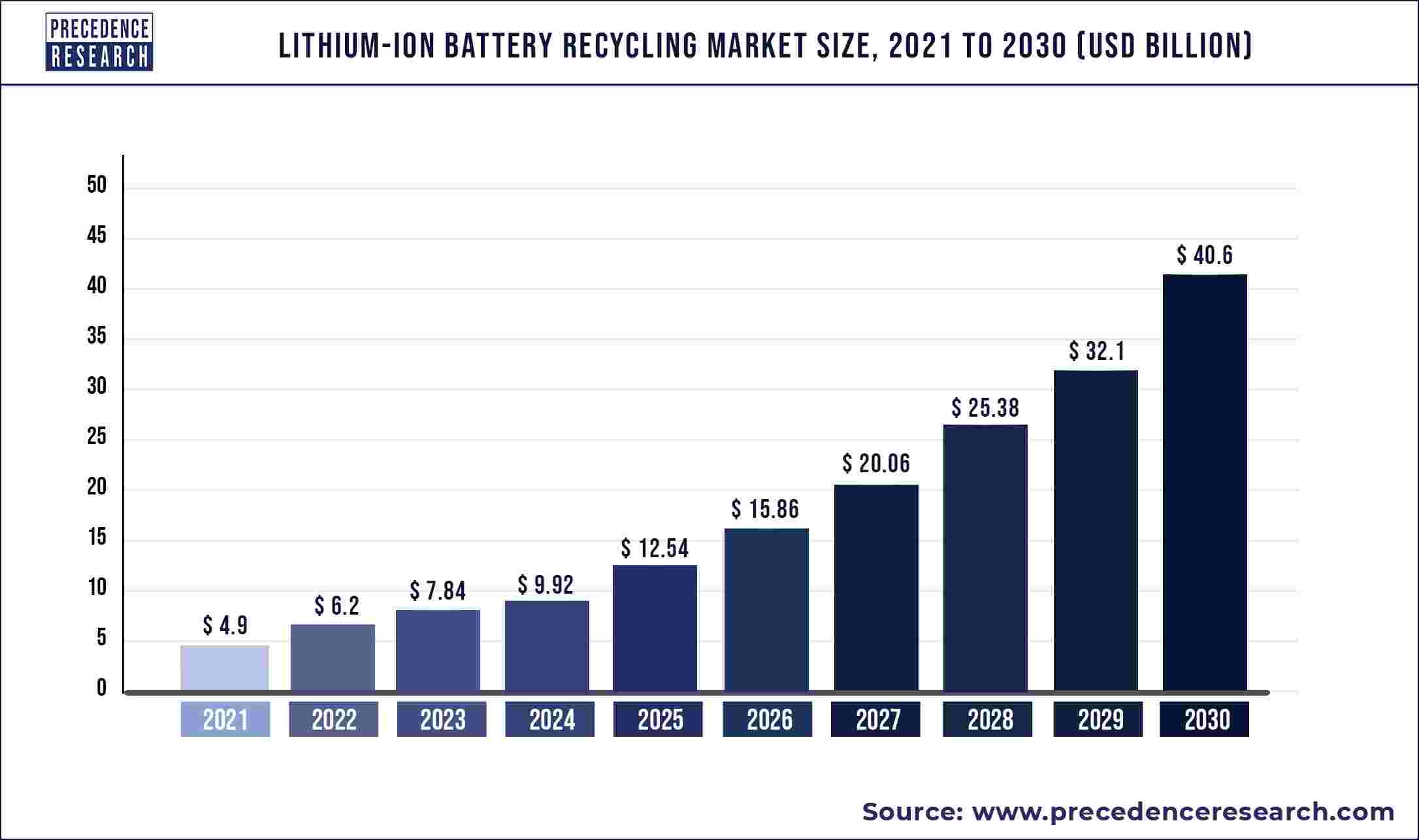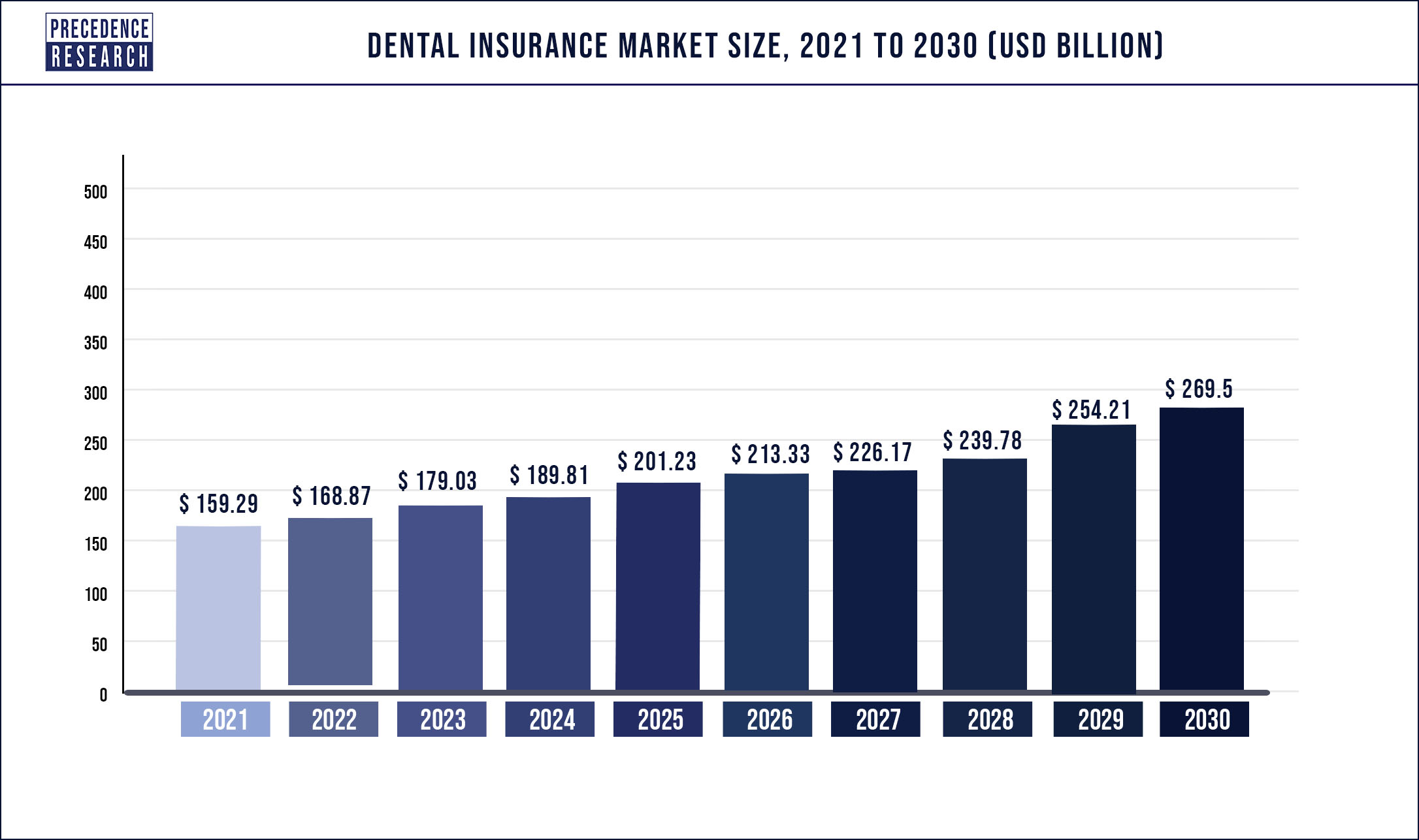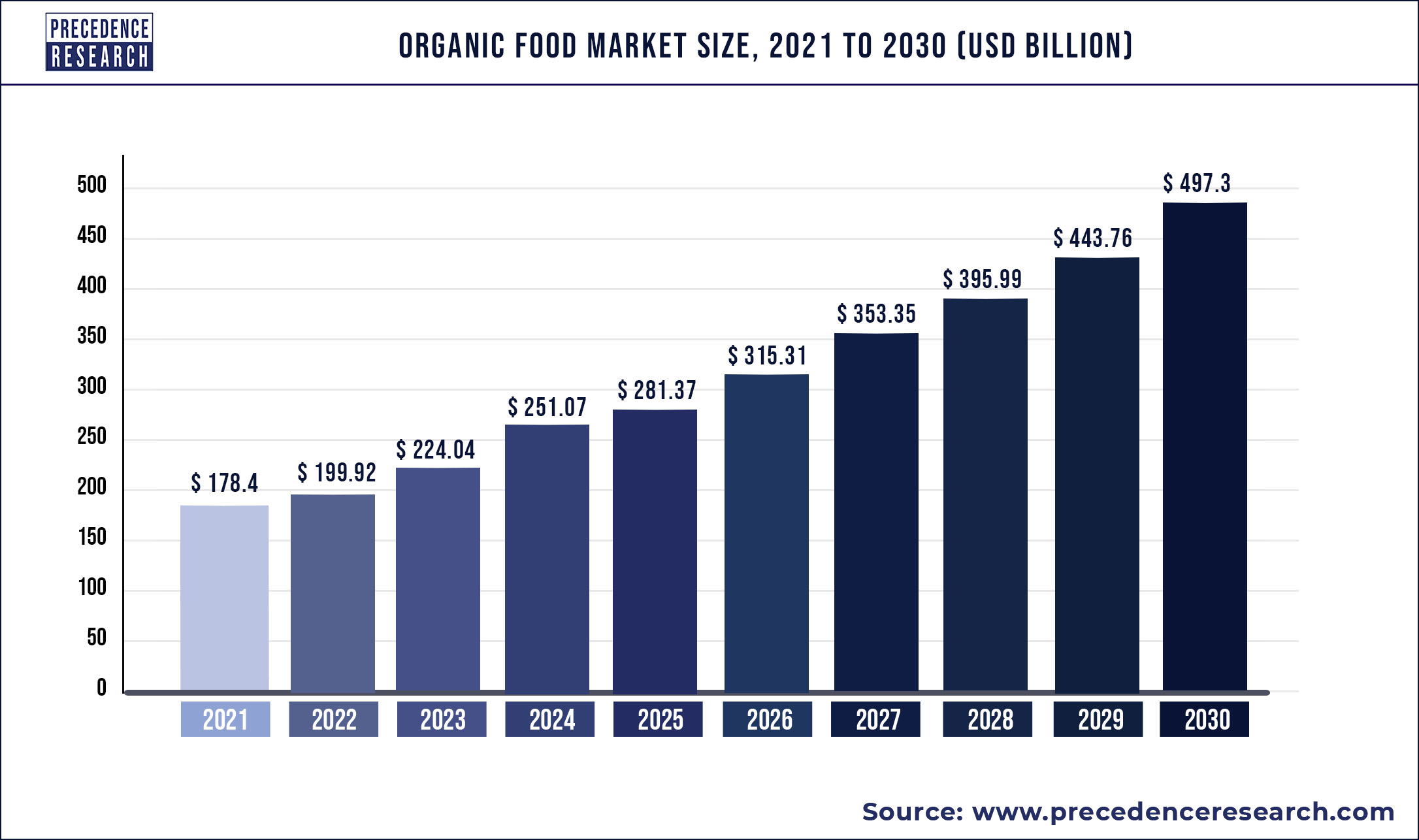According to Precedence Research, during the forecast period of 2022 to 2030, the global lithium-ion battery recycling market is estimated to develop at a compound annual growth rate (CAGR) of 26.48%. The global lithium-ion battery recycling market was valued at USD 4.9 billion in 2021, and it is predicted to exceed USD 40.6 billion by 2030. The study investigates several elements and their consequences on the growth of the lithium-ion battery recycling market.
Download Free Sample Copy with TOC@ https://www.precedenceresearch.com/sample/2039
This report focuses on lithium-ion battery recycling market volume and value at the global level, regional level and company level. From a global perspective, this report represents overall lithium-ion battery recycling market size by analyzing historical data and future prospect. Regionally, this report focuses on several key regions: North America, Europe, Middle East & Africa, Latin America, etc.
The research report includes specific segments by region (country), by company, by all segments. This study provides information about the growth and revenue during the historic and forecasted period of 2017 to 2030. Understanding the segments helps in identifying the importance of different factors that aid the market growth.
Report Scope of the Lithium-ion Battery Recycling Market
| Report Coverage | Details |
| Market Size in 2022 | USD 6.2 Billion |
| Market Size by 2030 | USD 40.6 Billion |
| Growth Rate from 2022 to 2030 | CAGR of 26.48% |
| Base Year | 2021 |
| Forecast Period | 2022 to 2030 |
| Segments Covered | End User, Battery Components, Battery Chemistry, Recycling Process, Source, Geography |
In-Depth Analysis on Competitive Landscape
The report sheds light on leading manufacturers of lithium-ion battery recycling, along with their detailed profiles. Essential and up-to-date data related to market performers who are principally engaged in the production of lithium-ion battery recycling has been brought with the help of a detailed dashboard view. Market share analysis and comparison of prominent players provided in the report permits report readers to take preemptive steps in advancing their businesses.
Company profiles have been included in the report, which include essentials such as product portfolio, key strategies, along with all-inclusive SWOT analysis on each player. Company presence is mapped and presented through a matrix for all the prominent players, thus providing readers with actionable insights, which helps in thoughtfully presenting market status and predicting the competition level in the lithium-ion battery recycling market.
Some of the prominent players in the lithium-ion battery recycling market include:
- Accurec-Recycling GmbH (Germany)
- AkkuSer (Finland)
- American Manganese Inc. (Canada)
- American Zinc Recycling Corp (U.S.)
- Batrec Industrie AG (Switzerland)
- Battery Recycling Made Easy (BRME) (US)
- Contemporary Amperex Technology Co. Ltd (CATL) (China),
- DOWA ECO-SYSTEM Co., Ltd. (Japan)
- Duesenfeld GmbH (Germany)
- Ecobat (UK)
- Envirostream Australia Pty Ltd (Australia)
- Euro Dieuze Industrie (E.D.I.) (France)
- Fortum (Finland)
- GEM Co., Ltd (China)
- Glencore International AG (Switzerland)
- Lithion Recycling Inc. (Canada)
- Metal Conversion Technologies (MCT) (US)
- Neometals Ltd (Australia)
- OnTo Technology LLC (US)
- Raw Materials Company Inc. (RMC) (Canada)
- Redux GmbH (Germany)
- Redwood Materials, Inc. (US)
- Retriev Technologies Inc. (Canada)
- San Lan Technologies Co., Ltd (China)
- SITRASA (Mexico)
- SMC Recycling (US)
- SNAM (France)
- Sumitomo Metal Mining Co., Ltd. (Japan)
- Tata Chemicals Limited (India)
- TES (Singapore)
- Umicore (Belgium)
- uRecycle Group Oy (Finland)
Ask Here For More Customization Study@ https://www.precedenceresearch.com/customization/2039
Segments Covered in the Report
By End User
- Automotive
- Non-automotive
- Industrial
- Power
- Marine
- Others
By Battery Components
- Active Material
- Non-active Material
By Battery Chemistry
- Lithium-nickel Manganese Cobalt (Li-NMC)
- Lithium-iron Phosphate (LFP)
- Lithium-manganese Oxide (LMO)
- Lithium-titanate Oxide (LTO)
- Lithium-nickel Cobalt Aluminum Oxide (NCA)
By Recycling Process
- Hydrometallurgical Process
- Pyrometallurgy Process
- Physical/ Mechanical Process
By Source
- Electric Vehicles
- Electronics
- Power Tools
- Others
Regional Segmentation
- Asia-Pacific [China, Southeast Asia, India, Japan, Korea, Western Asia]
- Europe [Germany, UK, France, Italy, Russia, Spain, Netherlands, Turkey, Switzerland]
- North America [United States, Canada, Mexico]
- South America [Brazil, Argentina, Columbia, Chile, Peru]
- Middle East & Africa [GCC, North Africa, South Africa]
Some of the important ones are:
- What can be the best investment choices for venturing into new product and service lines?
- What value propositions should businesses aim at while making new research and development funding?
- Which regulations will be most helpful for stakeholders to boost their supply chain network?
- Which regions might see the demand maturing in certain segments in near future?
- What are the some of the best cost optimization strategies with vendors that some well-entrenched players have gained success with?
- Which are the key perspectives that the C-suite are leveraging to move businesses to new growth trajectory?
- Which government regulations might challenge the status of key regional markets?
- How will the emerging political and economic scenario affect opportunities in key growth areas?
- What are some of the value-grab opportunities in various segments?
- What will be the barrier to entry for new players in the market?
Table of Contents
Chapter 1. Introduction
1.1. Research Objective
1.2. Scope of the Study
1.3. Definition
Chapter 2. Research Methodology
2.1. Research Approach
2.2. Data Sources
2.3. Assumptions & Limitations
Chapter 3. Executive Summary
3.1. Market Snapshot
Chapter 4. Market Variables and Scope
4.1. Introduction
4.2. Market Classification and Scope
4.3. Industry Value Chain Analysis
4.3.1. Raw Material Procurement Analysis
4.3.2. Sales and Distribution Channel Analysis
4.3.3. Downstream Buyer Analysis
Chapter 5. COVID 19 Impact on Lithium-ion Battery Recycling Market
5.1. COVID-19 Landscape: Lithium-ion Battery Recycling Industry Impact
5.2. COVID 19 – Impact Assessment for the Industry
5.3. COVID 19 Impact: Global Major Government Policy
5.4. Market Trends and Opportunities in the COVID-19 Landscape
Chapter 6. Market Dynamics Analysis and Trends
6.1. Market Dynamics
6.1.1. Market Drivers
6.1.2. Market Restraints
6.1.3. Market Opportunities
6.2. Porter’s Five Forces Analysis
6.2.1. Bargaining power of suppliers
6.2.2. Bargaining power of buyers
6.2.3. Threat of substitute
6.2.4. Threat of new entrants
6.2.5. Degree of competition
Chapter 7. Competitive Landscape
7.1.1. Company Market Share/Positioning Analysis
7.1.2. Key Strategies Adopted by Players
7.1.3. Vendor Landscape
7.1.3.1. List of Suppliers
7.1.3.2. List of Buyers
Chapter 8. Global Lithium-ion Battery Recycling Market, By End User
8.1. Lithium-ion Battery Recycling Market, by End User, 2022-2030
8.1.1. Automotive
8.1.1.1. Market Revenue and Forecast (2017-2030)
8.1.2. Non-automotive
8.1.2.1. Market Revenue and Forecast (2017-2030)
Chapter 9. Global Lithium-ion Battery Recycling Market, By Battery Components
9.1. Lithium-ion Battery Recycling Market, by Battery Components, 2022-2030
9.1.1. Active Material
9.1.1.1. Market Revenue and Forecast (2017-2030)
9.1.2. Non-active Material
9.1.2.1. Market Revenue and Forecast (2017-2030)
Chapter 10. Global Lithium-ion Battery Recycling Market, By Battery Chemistry
10.1. Lithium-ion Battery Recycling Market, by Battery Chemistry, 2022-2030
10.1.1. Lithium-nickel Manganese Cobalt (Li-NMC)
10.1.1.1. Market Revenue and Forecast (2017-2030)
10.1.2. Lithium-iron Phosphate (LFP)
10.1.2.1. Market Revenue and Forecast (2017-2030)
10.1.3. Lithium-manganese Oxide (LMO)
10.1.3.1. Market Revenue and Forecast (2017-2030)
10.1.4. Lithium-titanate Oxide (LTO)
10.1.4.1. Market Revenue and Forecast (2017-2030)
10.1.5. Lithium-nickel Cobalt Aluminum Oxide (NCA)
10.1.5.1. Market Revenue and Forecast (2017-2030)
Chapter 11. Global Lithium-ion Battery Recycling Market, By Recycling Process
11.1. Lithium-ion Battery Recycling Market, by Recycling Process, 2022-2030
11.1.1. Hydrometallurgical Process
11.1.1.1. Market Revenue and Forecast (2017-2030)
11.1.2. Pyrometallurgy Process
11.1.2.1. Market Revenue and Forecast (2017-2030)
11.1.3. Physical/ Mechanical Process
11.1.3.1. Market Revenue and Forecast (2017-2030)
Chapter 12. Global Lithium-ion Battery Recycling Market, By Source
12.1. Lithium-ion Battery Recycling Market, by Source, 2022-2030
12.1.1. Electric Vehicles
12.1.1.1. Market Revenue and Forecast (2017-2030)
12.1.2. Electronics
12.1.2.1. Market Revenue and Forecast (2017-2030)
12.1.3. Power Tools
12.1.3.1. Market Revenue and Forecast (2017-2030)
12.1.4. Others
12.1.4.1. Market Revenue and Forecast (2017-2030)
Chapter 13. Global Lithium-ion Battery Recycling Market, Regional Estimates and Trend Forecast
13.1. North America
13.1.1. Market Revenue and Forecast, by End User (2017-2030)
13.1.2. Market Revenue and Forecast, by Battery Components (2017-2030)
13.1.3. Market Revenue and Forecast, by Battery Chemistry (2017-2030)
13.1.4. Market Revenue and Forecast, by Recycling Process (2017-2030)
13.1.5. Market Revenue and Forecast, by Source (2017-2030)
13.1.6. U.S.
13.1.6.1. Market Revenue and Forecast, by End User (2017-2030)
13.1.6.2. Market Revenue and Forecast, by Battery Components (2017-2030)
13.1.6.3. Market Revenue and Forecast, by Battery Chemistry (2017-2030)
13.1.6.4. Market Revenue and Forecast, by Recycling Process (2017-2030)
13.1.6.5. Market Revenue and Forecast, by Source (2017-2030)
13.1.7. Rest of North America
13.1.7.1. Market Revenue and Forecast, by End User (2017-2030)
13.1.7.2. Market Revenue and Forecast, by Battery Components (2017-2030)
13.1.7.3. Market Revenue and Forecast, by Battery Chemistry (2017-2030)
13.1.7.4. Market Revenue and Forecast, by Recycling Process (2017-2030)
13.1.7.5. Market Revenue and Forecast, by Source (2017-2030)
13.2. Europe
13.2.1. Market Revenue and Forecast, by End User (2017-2030)
13.2.2. Market Revenue and Forecast, by Battery Components (2017-2030)
13.2.3. Market Revenue and Forecast, by Battery Chemistry (2017-2030)
13.2.4. Market Revenue and Forecast, by Recycling Process (2017-2030)
13.2.5. Market Revenue and Forecast, by Source (2017-2030)
13.2.6. UK
13.2.6.1. Market Revenue and Forecast, by End User (2017-2030)
13.2.6.2. Market Revenue and Forecast, by Battery Components (2017-2030)
13.2.6.3. Market Revenue and Forecast, by Battery Chemistry (2017-2030)
13.2.6.4. Market Revenue and Forecast, by Recycling Process (2017-2030)
13.2.6.5. Market Revenue and Forecast, by Source (2017-2030)
13.2.7. Germany
13.2.7.1. Market Revenue and Forecast, by End User (2017-2030)
13.2.7.2. Market Revenue and Forecast, by Battery Components (2017-2030)
13.2.7.3. Market Revenue and Forecast, by Battery Chemistry (2017-2030)
13.2.7.4. Market Revenue and Forecast, by Recycling Process (2017-2030)
13.2.7.5. Market Revenue and Forecast, by Source (2017-2030)
13.2.8. France
13.2.8.1. Market Revenue and Forecast, by End User (2017-2030)
13.2.8.2. Market Revenue and Forecast, by Battery Components (2017-2030)
13.2.8.3. Market Revenue and Forecast, by Battery Chemistry (2017-2030)
13.2.8.4. Market Revenue and Forecast, by Recycling Process (2017-2030)
13.2.8.5. Market Revenue and Forecast, by Source (2017-2030)
13.2.9. Rest of Europe
13.2.9.1. Market Revenue and Forecast, by End User (2017-2030)
13.2.9.2. Market Revenue and Forecast, by Battery Components (2017-2030)
13.2.9.3. Market Revenue and Forecast, by Battery Chemistry (2017-2030)
13.2.9.4. Market Revenue and Forecast, by Recycling Process (2017-2030)
13.2.9.5. Market Revenue and Forecast, by Source (2017-2030)
13.3. APAC
13.3.1. Market Revenue and Forecast, by End User (2017-2030)
13.3.2. Market Revenue and Forecast, by Battery Components (2017-2030)
13.3.3. Market Revenue and Forecast, by Battery Chemistry (2017-2030)
13.3.4. Market Revenue and Forecast, by Recycling Process (2017-2030)
13.3.5. Market Revenue and Forecast, by Source (2017-2030)
13.3.6. India
13.3.6.1. Market Revenue and Forecast, by End User (2017-2030)
13.3.6.2. Market Revenue and Forecast, by Battery Components (2017-2030)
13.3.6.3. Market Revenue and Forecast, by Battery Chemistry (2017-2030)
13.3.6.4. Market Revenue and Forecast, by Recycling Process (2017-2030)
13.3.6.5. Market Revenue and Forecast, by Source (2017-2030)
13.3.7. China
13.3.7.1. Market Revenue and Forecast, by End User (2017-2030)
13.3.7.2. Market Revenue and Forecast, by Battery Components (2017-2030)
13.3.7.3. Market Revenue and Forecast, by Battery Chemistry (2017-2030)
13.3.7.4. Market Revenue and Forecast, by Recycling Process (2017-2030)
13.3.7.5. Market Revenue and Forecast, by Source (2017-2030)
13.3.8. Japan
13.3.8.1. Market Revenue and Forecast, by End User (2017-2030)
13.3.8.2. Market Revenue and Forecast, by Battery Components (2017-2030)
13.3.8.3. Market Revenue and Forecast, by Battery Chemistry (2017-2030)
13.3.8.4. Market Revenue and Forecast, by Recycling Process (2017-2030)
13.3.8.5. Market Revenue and Forecast, by Source (2017-2030)
13.3.9. Rest of APAC
13.3.9.1. Market Revenue and Forecast, by End User (2017-2030)
13.3.9.2. Market Revenue and Forecast, by Battery Components (2017-2030)
13.3.9.3. Market Revenue and Forecast, by Battery Chemistry (2017-2030)
13.3.9.4. Market Revenue and Forecast, by Recycling Process (2017-2030)
13.3.9.5. Market Revenue and Forecast, by Source (2017-2030)
13.4. MEA
13.4.1. Market Revenue and Forecast, by End User (2017-2030)
13.4.2. Market Revenue and Forecast, by Battery Components (2017-2030)
13.4.3. Market Revenue and Forecast, by Battery Chemistry (2017-2030)
13.4.4. Market Revenue and Forecast, by Recycling Process (2017-2030)
13.4.5. Market Revenue and Forecast, by Source (2017-2030)
13.4.6. GCC
13.4.6.1. Market Revenue and Forecast, by End User (2017-2030)
13.4.6.2. Market Revenue and Forecast, by Battery Components (2017-2030)
13.4.6.3. Market Revenue and Forecast, by Battery Chemistry (2017-2030)
13.4.6.4. Market Revenue and Forecast, by Recycling Process (2017-2030)
13.4.6.5. Market Revenue and Forecast, by Source (2017-2030)
13.4.7. North Africa
13.4.7.1. Market Revenue and Forecast, by End User (2017-2030)
13.4.7.2. Market Revenue and Forecast, by Battery Components (2017-2030)
13.4.7.3. Market Revenue and Forecast, by Battery Chemistry (2017-2030)
13.4.7.4. Market Revenue and Forecast, by Recycling Process (2017-2030)
13.4.7.5. Market Revenue and Forecast, by Source (2017-2030)
13.4.8. South Africa
13.4.8.1. Market Revenue and Forecast, by End User (2017-2030)
13.4.8.2. Market Revenue and Forecast, by Battery Components (2017-2030)
13.4.8.3. Market Revenue and Forecast, by Battery Chemistry (2017-2030)
13.4.8.4. Market Revenue and Forecast, by Recycling Process (2017-2030)
13.4.8.5. Market Revenue and Forecast, by Source (2017-2030)
13.4.9. Rest of MEA
13.4.9.1. Market Revenue and Forecast, by End User (2017-2030)
13.4.9.2. Market Revenue and Forecast, by Battery Components (2017-2030)
13.4.9.3. Market Revenue and Forecast, by Battery Chemistry (2017-2030)
13.4.9.4. Market Revenue and Forecast, by Recycling Process (2017-2030)
13.4.9.5. Market Revenue and Forecast, by Source (2017-2030)
13.5. Latin America
13.5.1. Market Revenue and Forecast, by End User (2017-2030)
13.5.2. Market Revenue and Forecast, by Battery Components (2017-2030)
13.5.3. Market Revenue and Forecast, by Battery Chemistry (2017-2030)
13.5.4. Market Revenue and Forecast, by Recycling Process (2017-2030)
13.5.5. Market Revenue and Forecast, by Source (2017-2030)
13.5.6. Brazil
13.5.6.1. Market Revenue and Forecast, by End User (2017-2030)
13.5.6.2. Market Revenue and Forecast, by Battery Components (2017-2030)
13.5.6.3. Market Revenue and Forecast, by Battery Chemistry (2017-2030)
13.5.6.4. Market Revenue and Forecast, by Recycling Process (2017-2030)
13.5.6.5. Market Revenue and Forecast, by Source (2017-2030)
13.5.7. Rest of LATAM
13.5.7.1. Market Revenue and Forecast, by End User (2017-2030)
13.5.7.2. Market Revenue and Forecast, by Battery Components (2017-2030)
13.5.7.3. Market Revenue and Forecast, by Battery Chemistry (2017-2030)
13.5.7.4. Market Revenue and Forecast, by Recycling Process (2017-2030)
13.5.7.5. Market Revenue and Forecast, by Source (2017-2030)
Chapter 14. Company Profiles
14.1. Accurec-Recycling GmbH (Germany)
14.1.1. Company Overview
14.1.2. Product Offerings
14.1.3. Financial Performance
14.1.4. Recent Initiatives
14.2. AkkuSer (Finland)
14.2.1. Company Overview
14.2.2. Product Offerings
14.2.3. Financial Performance
14.2.4. Recent Initiatives
14.3. American Manganese Inc. (Canada)
14.3.1. Company Overview
14.3.2. Product Offerings
14.3.3. Financial Performance
14.3.4. Recent Initiatives
14.4. American Zinc Recycling Corp (U.S.)
14.4.1. Company Overview
14.4.2. Product Offerings
14.4.3. Financial Performance
14.4.4. Recent Initiatives
14.5. Batrec Industrie AG (Switzerland)
14.5.1. Company Overview
14.5.2. Product Offerings
14.5.3. Financial Performance
14.5.4. Recent Initiatives
14.6. Battery Recycling Made Easy (BRME) (US)
14.6.1. Company Overview
14.6.2. Product Offerings
14.6.3. Financial Performance
14.6.4. Recent Initiatives
14.7. Contemporary Amperex Technology Co. Ltd (CATL) (China)
14.7.1. Company Overview
14.7.2. Product Offerings
14.7.3. Financial Performance
14.7.4. Recent Initiatives
14.8. DOWA ECO-SYSTEM Co., Ltd. (Japan)
14.8.1. Company Overview
14.8.2. Product Offerings
14.8.3. Financial Performance
14.8.4. Recent Initiatives
14.9. Duesenfeld GmbH (Germany)
14.9.1. Company Overview
14.9.2. Product Offerings
14.9.3. Financial Performance
14.9.4. Recent Initiatives
14.10. Ecobat (UK)
14.10.1. Company Overview
14.10.2. Product Offerings
14.10.3. Financial Performance
14.10.4. Recent Initiatives
Chapter 15. Research Methodology
15.1. Primary Research
15.2. Secondary Research
15.3. Assumptions
Chapter 16. Appendix
16.1. About Us
16.2. Glossary of Terms
Buy This Premium Research Report Click Here@ https://www.precedenceresearch.com/checkout/2039
About Us
Precedence Research is a Canada/India based company and one of the leading providers of strategic market insights. We offer executive-level blueprints of markets and solutions beyond flagship surveys. Our repository covers consultation, syndicated market studies, and customized research reports. Through our services we aim at connecting an organization’s goal with lucrative prospects globally.
From gauging investment feasibility to uncovering hidden growth opportunities, our market studies cover in-depth analysis, which also is interspersed with relevant statistics. Recommendation are often enclosed within our reports with the sole intent of enabling organizations achieve mission-critical success.
Contact Us:
Precedence Research
Apt 1408 1785 Riverside Drive Ottawa, ON, K1G 3T7, Canada
Call: +1 9197 992 333
Email: sales@precedenceresearch.com
Website: https://www.precedenceresearch.com




